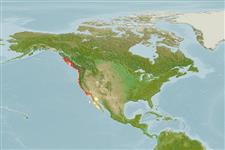Classification / Names
Common names from other countries
Main reference
Size / Weight / Age
Max length : 610 cm TL male/unsexed; (Ref. 1998); common length : 21.0 cm TL male/unsexed; (Ref. 12193); max. published weight: 816.0 kg (Ref. 27436); max. reported age: 104 years (Ref. 39377)
Length at first maturity
Lm 160.0 range ? - ? cm
Environment
Marine; freshwater; brackish; demersal; anadromous (Ref. 51243); depth range 1 - 122 m (Ref. 27547)
Climate / Range
Subtropical; ? - 23°C (Ref. 1998), preferred 16°C (Ref. 107945); 58°N - 24°N, 163°W - 107°W (Ref. 54269)
Distribution
Eastern Pacific: Alaska Bay to Monterey, California, USA. Landlocked in Columbia River drainage, Montana, and perhaps Lake Shasta in California, USA. Translocated to lower Colorado River, Arizona in USA. Reported from northern Baja California, Mexico (Ref. 2850, 27436). Considered vulnerable in Canada (Ref. 6866). International trade restricted (CITES II, since 1.4.98).
Countries | FAO areas | Ecosystems | Occurrences | Introductions
Short description
Dorsal
spines
(total): 0;
Dorsal
soft rays
(total): 44-48;
Anal
soft rays: 28 - 31. Distinguished by the 2 rows of 4 to 8 bony plates on a midventral line between the anus and anal fin, and about 45 rays in the dorsal fin (Ref. 27547). Gray or brownish above, paler below; fins gray (Ref. 27547). Barbels situated closer to snout tip than to mouth; no obvious scutes behind dorsal and anal fins (Ref. 86798).
IUCN Red List Status (Ref. 115185)
Threat to humans
Harmless
Human uses
Fisheries: commercial; aquaculture: commercial; gamefish: yes
Tools
Special reports
Download XML
Internet sources
Estimates of some properties based on models
Phylogenetic diversity index
PD50 = 0.5000 many relatives (e.g. carps) 0.5 - 2.0 few relatives (e.g. lungfishes)
Trophic Level
3.3 ±0.1 se; Based on diet studies.
Resilience
Very Low, minimum population doubling time more than 14 years (tm=11-34; tmax=104)
Vulnerability
Very high vulnerability (87 of 100)
Price category
